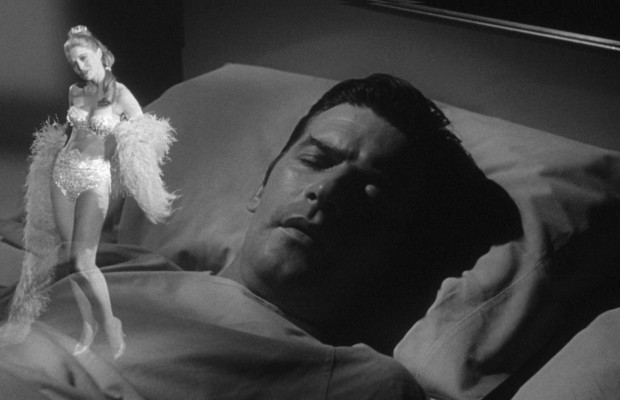Just as Douglas Sirk used melodrama as a vehicle (and a partial blind) for social commentary, writer/director Samuel Fuller utilized hardboiled noir and hallucinatory imagery to interrogate the ugly underpinnings of the American psyche. His films are full of sharp-witted prostitutes and strippers, nasty newspaper men, racists and bigots, mean pimps and meaner elites. Shock Corridor from 1963 is one of his bluntest and evocative films, dealing with a newspaperman who enters an insane asylum to solve a murder and finds a horrific amalgam of contemporary American madness.

Shock Corridor features Peter Breck as Johnny Barrett, a journalist obsessed with winning the Pulitzer Prize. Johnny has spent the better part of a year learning how to be convincingly crazy so that he’ll be committed to an asylum where a patient named Sloan was murdered. Barrett is backed up by his girlfriend Cathy (Constance Towers), who thinks that he’s endangering his own sanity, his boss Swanee (Bill Zuckert), and a psychiatrist friend Dr. Fong (Philip Ahn). Cathy finally agrees to help him, posing as his sister about whom he has incestuous desires, and Johnny winds up in the asylum. There he has to find three key witnesses: Stuart (James Best), a former soldier who thinks he’s Confederate General J.E.B. Stuart, Trent (Hari Rhodes), the only black student at a Southern university who now believes he’s a white supremacist, and Boden (Gene Evans), a renowned physicist who worked on the atom bomb and now has the mentality of a six-year-old. As Barrett digs deeper into the murder, he’s subjected to psychological tests, shock treatment, and the slow unraveling of his own sanity in a twisted world of pathologies and alternate realities.
Fuller uses the asylum and its patients as a conduit to the psychosis of contemporary America. The three witnesses – Stuart, Trent, and Boden – each represent contemporary anxieties (the red scare, bigotry and racism, and nuclear destruction). Johnny is the Everyman who willingly enters into this world, believing that he can maintain his sanity in the face of madness, and there must confront the insanity of his culture. Johnny begins to develop his own pathologies, already hinted at before he’s committed – the first act of the film utilizes sexual deviation as the catalyst for his performance of madness when he pretends that his real-life girlfriend is his sister. He later imagines Cathy dancing on his chest, asking why he cares more about winning a prize than about her, and then seems to convince himself that she is actually his sister and not his lover. Sexual repression overlaps with the film’s other concerns, creating a fascinating symbiosis of themes that becomes an amalgam of the American psyche. Each of the “madmen” (including Johnny) retreat into insanity to both avoid and analogically enact the horrors of the outside world, from the treacherous soldier who becomes a Confederate general to the black man who becomes his own persecutor.
While the word “hallucinatory” gets thrown around about much of Fuller’s work, the strength of Shock Corridor is actually how little Fuller manipulates the image. He constructs scenes and films them in a fairly straightforward manner, even as madness occurs onscreen. In one sequence, Johnny is attacked by a group of female nymphomaniacs, and the horror of the scene is in how apparently banal and unavoidable it seems, the women mobbing Johnny as he shrieks for help. There are some cinematographic flights, as in Johnny’s fantasies about Cathy dancing on his chest, but for the most part Shock Corridor depends on noir imagery, not surrealism. The horror of the film is in how normal the madness seems.
There is a surprising explicitness in Shock Corridor absent from most of the Hollywood products of the period. Cathy is a stripper, doing the job because “it pays better than typing.” Unlike Johnny, she is able to divide her professional and personal life, viewing her work as simply a job that helps her to get paid and put away money for the future. Her early scene with Johnny as she tries to convince him to abandon the asylum idea is a masterpiece of hardboiled dialogue coupled with a straightforward and oddly progressive viewpoint: Cathy is the most intelligent person involved, and her fears for Johnny are founded in common sense and a complex understanding of psychology. While Fuller would make better use of Towers in The Naked Kiss, she’s a complicated and grounded presence here.
Shock Corridor remains topical, despite being made almost sixty years ago. It’s an essential, intense film, discombobulating and horrifying. The power of Fuller’s work hasn’t lessened because the madness of America has not really changed.
Shock Corridor is available to stream on YouTube and to rent on Amazon Prime.


